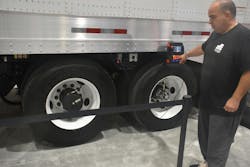Range demonstrates powered trailer solution, ROI tool
At TMC, Range Energy displayed its powered trailer solution and launched an operational expenditure (OpEx) savings calculator for commercial fleet owners and operators.
The first-of-its-kind online calculator captures and analyzes unique data points from fleets, including the price they pay for diesel fuel, baseline fuel efficiency, current electricity costs, and miles driven per year to determine overall maintenance, fuel, and electricity savings from the implementation of electric powered trailers within their existing fleets.
Preliminary third-party testing data and early customer pilots have shown Range’s electric trailers generate fuel efficiency gains of nearly 40%, 300 miles of full assist range, and can cut NOx emissions by up to 70%, according to the company.
Range’s electric powered trailers allow fleets to immediately progress towards their electrification goals as the equipment is compatible with all diesel-powered tractors today as well as future electric semis. The OpEx calculator underscores the critical addition of Range’s technology to today’s fleets as it can uniquely measure and compare the way each fleet operates today and how implementing electric trailers can enable fuel, electricity, and maintenance savings.
“Range’s trailers are a futureproof investment as they’re cost effective and deliver emissions improvements today that will only enhance over time,” said Ali Javidan, CEO and founder, Range Energy. “The OpEx calculator is a valuable resource that puts critical data into the hands of fleet owners and operators to better comprehend the cost and efficiency benefits they can achieve today. Our trailers are built to serve as an accelerant for the electric transition, meeting fleets’ immediate needs and long-term ambitions.”
Javidan, who was an early employee at Tesla, told Trailer/Body Builders that the Range team is made up of EV veterans.
“We've developed a lot of the vehicles that you see on the road today,” Javidan said. “There is no other team that can develop a full, soup-to-nuts powertrain with the battery pack with the e-axle, along with the safety system.”
Indeed, he emphasized the critical importance of safety, and hinted that Range will have a demonstration of the superior trailer control the system is capable of at the upcoming ACT Expo.
Javidan also noted that he’d grown up on a farm in California’s Central Valley and was driving trucks and pulling trailers before he even had a driver’s license. And so, after a long career in Silicon Valley, he’s returning to his roots in a way.
“In early 2021, after six years at Zoox helping develop the Level 5 robo-taxi, I started to think about my next career move,” he said. “And so as I looked around, I had this kind of inherent desire to enter the commercial decarbonization space. For the commercial trucking industry, I started to look at the work that Volvo, Freightliner, and my old friends at Tesla are doing.
“One of the immediate things that came to my mind was the trailers were the same for every one of these solutions. It's just a box, and there’s really nothing being improved on the trailer itself.”
With a round of seed funding in the bank, the new team built its first prototype, and saw a 40% improvement in fuel economy on a Ford F-250, and double the towing range for a Rivian EV.
“We immediately realized the opportunity,” Javidan said. “So, basically, since August of 2022, we've been focused on Class 8 trailers. This is not this is not a college project for us.”
Range currently has two trailers on the road, in use by fleets in “a dozen or so lanes” and every sort of load scenario.
“[The Range system] adds around 4,000-5,000 lbs. to the weight of the trailer, so we do have to be mindful of how we load the trailer; the slider still works, and we can move the slider to balance the load,” he said. “But only 20-30% of loads are maxed out, so there is a need for this solution.”
Additionally, Range is working with several top trailer manufacturers on their lightweighting technology, and Javidan suggested Range-equipped trailers “within a few years” will have a net-zero load sacrifice.
He anticipates ramping up production to provide early fleet customers 20 or so Range-equipped trailers at a time “to build confidence” in the system.
“It’s a walk-before-you-run mentality. We want to we want to build trust at every step, and building trust in this in this industry is ‘give me a few; let me try it out,’” Javidan said.
The OpEx calculator is the most recent example of Range’s progression and maturation, and comes on the heels of $23.5 million in new financing from Trousdale Ventures, UP.Partners, R7, and Yamaha Motor Ventures. In the last year Range has also debuted its first powered 53' dry van, completed third-party testing with MVTS showing 36.9 percent fuel efficiency, launched its Dealer Advisory Council with top commercial OEM dealers, and became the first trailer electrification platform eligible for California’s Clear Off-Road Equipment (CORE) voucher incentive project.
About the Author
Kevin Jones
Editor
Kevin has served as editor-in-chief of Trailer/Body Builders magazine since 2017—just the third editor in the magazine’s 60 years. He is also editorial director for Endeavor Business Media’s Commercial Vehicle group, which includes FleetOwner, Bulk Transporter, Refrigerated Transporter, American Trucker, and Fleet Maintenance magazines and websites.
Working from Beaufort, S.C., Kevin has covered trucking and manufacturing for nearly 20 years. His writing and commentary about the trucking industry and, previously, business and government, has been recognized with numerous state, regional, and national journalism awards.

